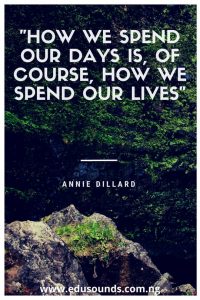
The line of words is a hammer. You hammer against the walls of your house. You tap the walls, lightly, everywhere…Some of the walls are bearing walls; they have to stay, or everything will fall down. Other walls can go with impunity; you can hear the difference. Unfortunately, it is often a bearing wall that has to go. It cannot be helped. There is only one solution, which appalls you, but there it is. Knock it out.
I have not, personally, come across a book that made use of so many metaphors within a very short space of pages to explain an idea or an act, like Dillard’s “The writing life”. She made tremendous use of metaphors with particular focus on buildings and insects. Likewise, she used anecdotes to show the fragility of writing and the defensiveness of writers. For instance, there was the case of a shaking building that the builders refused to accept the danger alertness from an observer across the road about the trembling of the building, and the eventual calamity that befell not only the person alerted by the observer about the shaking building but some of the builder’s co-construction workers. Furthermore, there was her use – like an entomologist – of the analogy of how a caterpillar’s metamorphosis leads into a butterfly to describe the writing process.

Likewise, there were notions by her that reflect the dangers inherent in a writer not accepting that, even though much efforts might have been put into a writing piece, the reality should be if a writing piece is not good enough a writer should be humble enough to put aside his or her ego and let go, without causing any calamity to the reader. This calamity could be in the loss of valuable time or money to the reader or worse still, emotional trauma.

Dillard looked into different professions and objects for inspirations in describing her writing experience. She was very fond of using buildings as points of reference on the writing process. Her use of loneliness and boredom in describing the writing process and being a writer were completed with her love for the outside world and seeking inspirations from nature and the stories of other writers. To her, writing was akin to life and death and this she succinctly puts across when she said:
Write as if you were dying. At the same time, assume you write for an audience consisting solely of terminal patients. That is, after all, the case. What would you begin writing if you knew you would die soon? What could you say to a dying person that would not enrage by its triviality?
At a point she questioned the impact of a writer’s work beyond the writer’s imagination:
Writing is mere writing, literature is mere. It appeals only to the subtlest senses – the imagination’s vision, and the imagination’s hearing – and the moral sense, and the intellect. This writing that you do, that so thrills you, that so rocks and exhilarates you, as if you were dancing next to the band, is barely audible to anyone else.
She wondered about her not having children of her own and perhaps, the joys she might be missing from such an experience; and to culminate that self questioning, she talked about the story of two boys who had come in into her apartment and played in the house, and how one of them had innocently interpreted one of her writings that most people struggle to understand except a literary critic. And briskly she moved on from her encounter with the two boys – 6 and 7 years old.

She ended the book with two anecdotal experiences she had with two creatives – an artist (painter) and a geologist cum stunt pilot – and how their practices had endured loneliness, continuous strive towards perfection and their enjoying moments and their respective journeys more than the inn. And she culminated it with the belief that not every work of art could be tangibly felt but some are best appreciated from fond memories of experiencing them in the moments that they happened, and at the same time she questioned if art can truly be seen as the peak of human’s creative endeavours.
Please, leave your thoughts on this post in the comment section and feel free to share the article with your contacts.
Thanks for taking out of your precious time to read my article/s!
If you like this post, kindly subscribe and/or follow me on Twitter @otukogbe and @EdusoundsNg or on Facebook at edusoundsng.